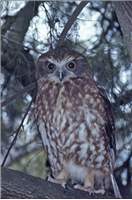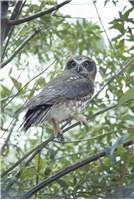Family
Strigidae
Genus
Ninox
Species
novaeseelandiae
Threats/Control Methods - Regional
The Southern Boobook seems to be more resilient to the declining tree hollows than other species, however their successful breeding is still threatened by land clearing and competition for nest hollows from other birds, such as the Common Myna (Acridotheres tristis ) and the Common Starling (Sturnus vulgaris ), and the Brush-tailed possum (Trichosurus vulpecular).
Threats/Control Methods - Local
The removal of mature eucalypt trees from the suburbs is minimising the availability of suitable nesting hollows. Free roaming domestic Cats (Felis catus) may also hunt the young Boobooks in their nest.
Local/Urban Actions
The protection of remnant vegetation containing dead and mature trees with hollows is important for maintaining Southern Boobook populations. Participating in tree planting or bush regeneration activities with local Landcare groups or with Greening Australia will ensure suitable habitat remains into the future. Cat owners can prevent their pets preying on the species by installing a cat run or enclosure. Residents can also build a nest box for their breeding and shelter. Provide a vertical nest box at least 5m from the ground, with an entrance diameter of 12cm and an inside diameter of 40 cm is ideal.
Common Names
Boobook Owl, Mopoke, Morepork
Distinguishing Features
The Southern Boobook is the smallest of the Australian owls at 25-35cm. It has a brown face with a dark ring around its large yellow eyes. Its face also has a light X-shape centred just above its small pointed bill. The back and wings are dark red-brown with white spots. Underparts are a lighter red-brown shade with white patches. The feet are yellow and legs are covered with pale feathers. Young birds have white underparts with some light brown streaks and very obvious dark eye rings.
Survey Techniques
Usually call identification from night calling.
Species Call
A mellow double hoot of 'boo-book' or 'mo-poke' with a lower-pitched second hoot.
Similar Species
The Barking Owl (Ninox connivens) is a slightly larger species with lighter coloured plumage and streaks instead of spots.
Distribution
This species is common across most of Australia, excluding the most arid regions.
Country of Origin
Australia
Conservation (Pet/Pest) Status - Regional
This species is fairly common and numbers have remained stable in past years.
Conservation (Pet/Pest) Status - National
Secure, not listed under the EPBC Act 1999. This is the most common and widespread of the Australian Owls.
Associated vegetation community
Any region with trees, especially eucalypt forest or woodland areas.
Limiting Resources
This species depends on areas with mature trees with hollows for nesting. It also needs trees with thick, leafy branches for roosting on during the day.
Breeding
The Southern Boobook carries out breeding activities from August to December. They use a range of tree hollows as nests, from those in high tree branches to low stumps, and sometimes rock crevices. 2-3 white, round eggs are laid and incubated by the female for about 34 days. The young birds are ready to leave the nest after about 5 weeks, however they may be dependant on their parents for several months.
Behaviour
The Southern Boobook is nocturnal and is most active and vocal at night. This species can be heard calling most in spring and early summer, as this is when numbers are highest in the Canberra region. During these months it can be seen perched during the day in dense tree foliage or grabbing insects from the air.
Functional Group
Food Species
The Southern Boobook eats mostly insects and arthropods, however sometimes small birds or mammals are also taken.
Predators
Feral or domestic Cats (Felis catus) can predate young birds in the nest.
Interesting Fact
The calls of the Southern Boobook are often a pair of owls calling to one another in a duet, gradually adding excitement and diversity to the call.
References - (reader suitability of references, P=Primary teachers, S=Secondary students, T=Tertiary students and researchers)
Books:Delgale, J. 1997. Attracting Birds to your Garden in Australia. New Holland Publishing. NSW. P, S, T
Morcombe, M. 2000. Field Guide to Australian Birds. Steve Parish Publishing. Archerfield. Australia P, S, T
Veerman, P. 2003. Canberra Birds: A report on the first 21 years of the garden bird survey. Philip Veerman and Canberra Ornithologists Group. Canberra. S, T
Internet: Birds in Backyards. 2006. [online]. Available at:http://www.birdsinbackyards.net P, S, T
Canberra Ornithological Group (COG). 2004. Birds of Canberra Gardens. COG and the ACT Department of Urban Services. [online]. Available at:http://garden.canberrabirds.org.au/ P, S, T
Online Publications:Olsen, P. et al. 2005. The State of Australia's Birds 2006: Invasive Species. Supplement to Wingspan 16:4. Birds Australia. [online]. Available at: http://www.birdsaustralia.com.au/soab/SOAB2006.pdf S, T


 Top
Top Top
Top